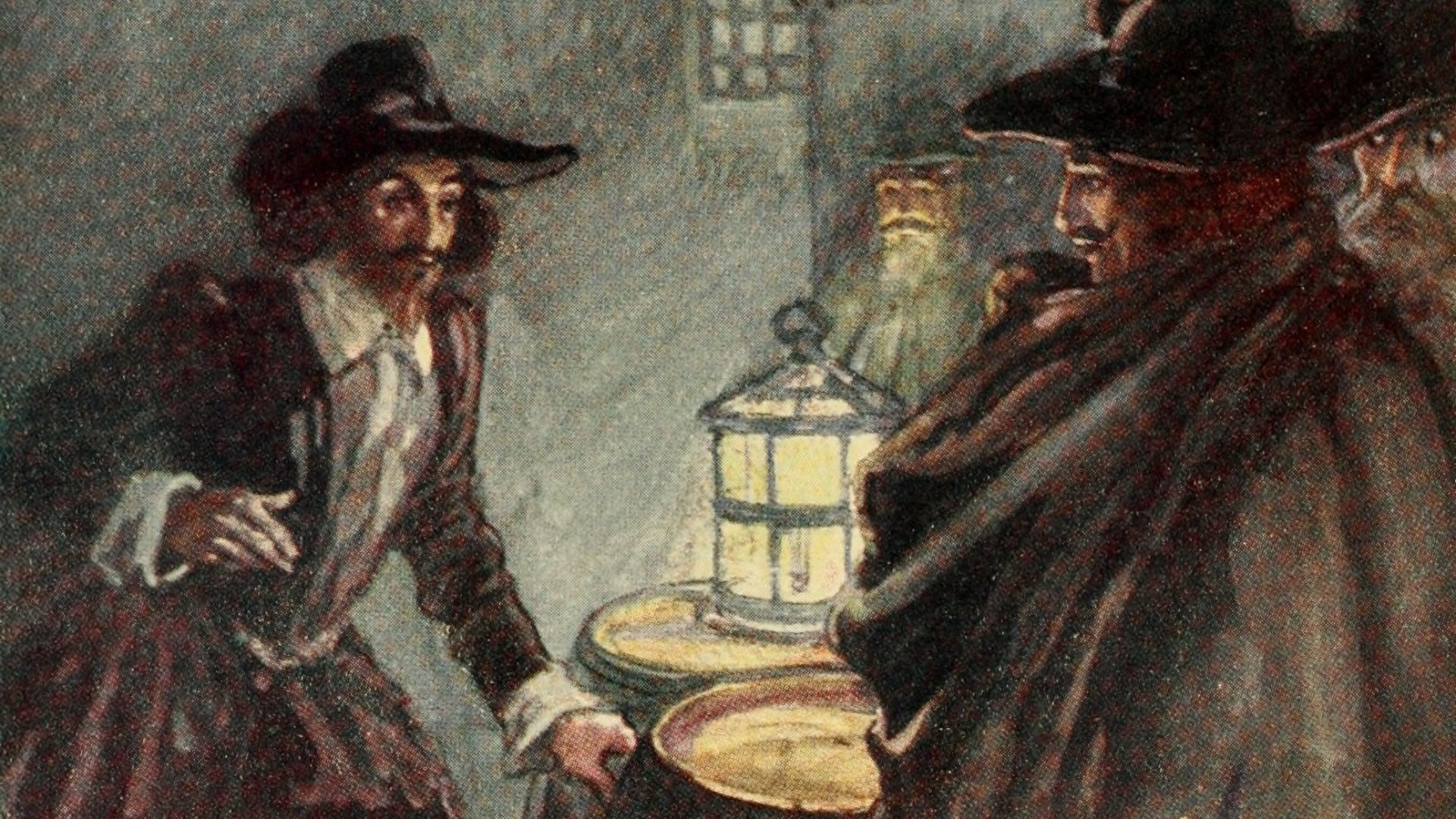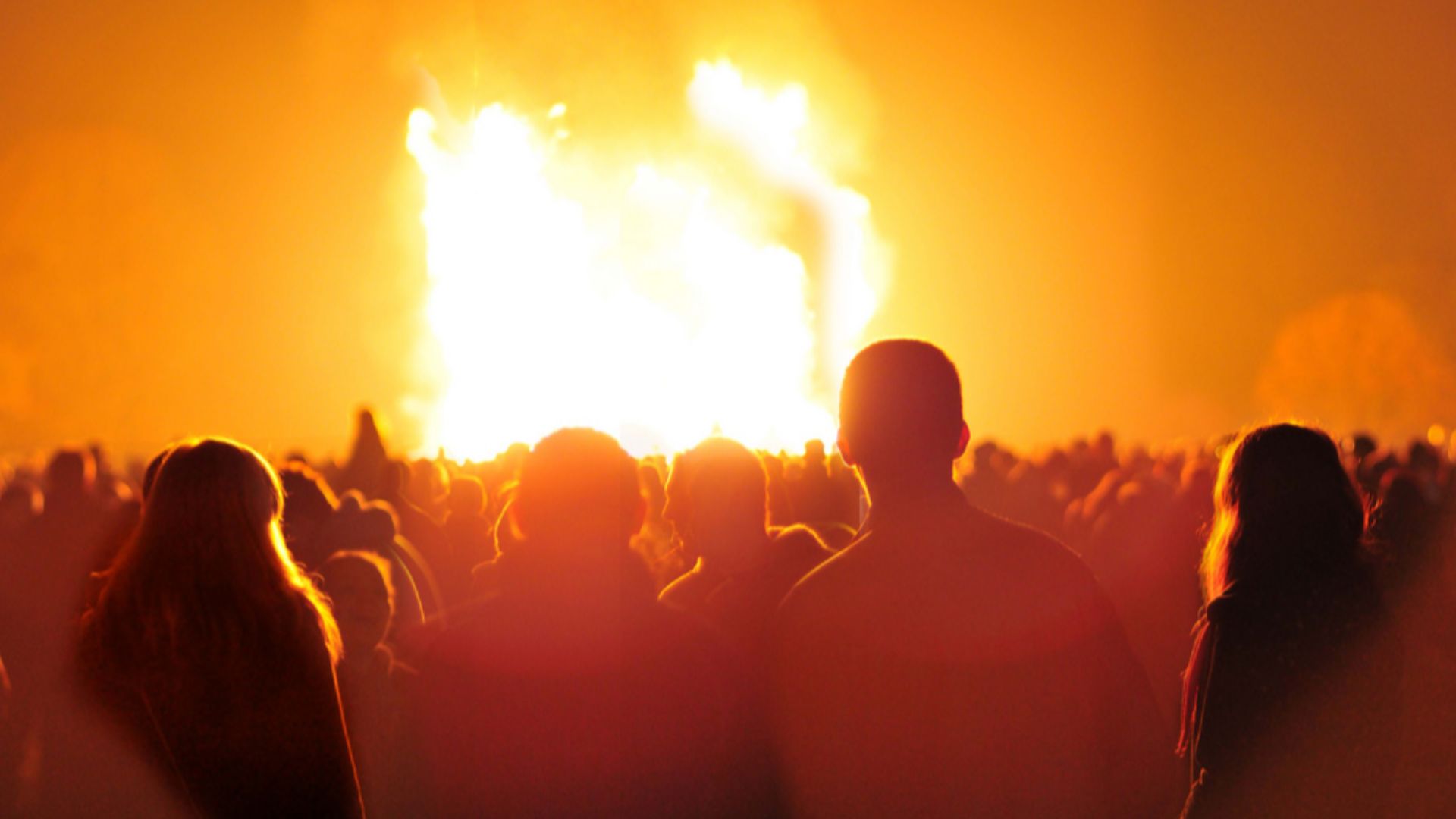Tonight, bonfires and fireworks will be going off across England. Guy Fawkes Night is the rare holiday which celebrates not success, but failure—specifically, a failed assassination plot against the King of England. Let's dive into the 400-year history behind this holiday.
 Internet Archive Book Images on Wikimedia
Internet Archive Book Images on Wikimedia
So, who was Guy Fawkes, and why is his likeness used by the hackers of Anonymous? Guy Fawkes (or Guido, when he was fighting for the Spanish) was an English spy, soldier, and Catholic conspirator. England was a nation divided between the Anglican and Catholic churches, thanks to Henry VIII and one of the messiest divorces in history.
Popish Pyrotechnics
Since England had officially broken from the Catholic church in the 1534, there were multiple Catholic plots to steer the country back to the true church. "Bloody" Mary I executed almost 300 Protestants during her short reign, while her younger sister, Elizabeth I restored a moderate form of Protestantism. Elizabeth herself nearly lost the throne thanks to a plot to replace her with her Catholic cousin, Mary, Queen of Scots (which eventually resulted in Mary losing her head).
Following this Popish Plot, Catholics were viewed as enemies within and were driven into hiding. Many of the gentry maintained their Catholicism in secret, believing it to be a private matter that had nothing to do with the throne. Others weren't so covert.
When James I took the throne after Elizabeth, he swore a tolerable attitude towards Catholics, signing a peace treaty with Spain, and preferring exile over capital punishment. When James took the throne, religious tensions were heating up in Europe, with many nations engaged in religious war. These tensions came to a head in England with the gunpowder plot.
Gunpowder, Treason, And Plot
While Guy Fawkes may have been the most famous conspirator, he was one of 13 and not even the ringleader! That title belonged to Robert Catesby, a handsome and persuasive man who'd taken part in a previous (failed) rebellion. Catesby gathered his supporters and began planning a new, more daring plot.
They were to blow up the Palace of Westminster the day the king opened parliament, killing him, his heir, and his fellow Protestants. The next step was less clear. With England in a state of chaos, they would lead a Catholic uprising, kidnap one of the princesses, and have a Catholic nobleman rule on her behalf. All they had to do was successfully light the fuse.
So, if Catesby was the mastermind, why isn't the holiday called Robert Catesby Night? While Catesby was the man with the plan, Fawkes was tasked with setting off the powder keg. His military experience made him the perfect choice to light the match. Unfortunately, things didn't go according to plan.
Parliament was set to open on November 5th. On October 26, an anonymous letter advised Protestant noblemen to stay home from parliament, lest they "receive a terrible blow". So, there went the hopes of flying under the radar. A few days later, Fawkes was discovered in the undercroft, along with his 36 barrels of gunpowder. And so the plan was foiled.
Fawkes was arrested and tortured. He and his surviving conspirators (half of them were killed in a shoot-out) were convicted of treason and sentenced to hanging, drawing, and quartering. Fawkes was spared the agony, as his neck broke immediately during his hanging.
 SJNikon - Sam Roberts on Wikimedia
SJNikon - Sam Roberts on Wikimedia
A Fiery Celebration
The following year, the "Thanksgiving Act" was passed to celebrate the king's deliverance by divine intervention. Unsurprisingly, some of the earliest celebrations involved setting off kegs of gunpowder. Original celebrations were far more hostile to Catholics, burning effigies of the pope. It was only in 1800, following the union of Great Britain and Ireland that Guy Fawkes replaced the pope as bonfire bogeyman.
Today, Bonfire Night is one the UK's most popular holidays, surpassing Halloween. In addition to large bonfires and celebrations, families set off fireworks of their own. While Catholic-Protestant religious tension is nowhere near the issue it used to be, Guy Fawkes Night is a way to have fun and put some light back into the world as the days get shorter and the nights get colder.
Remember, remember, the 5th of November,
Gunpowder, treason and plot.
I see no reason
Why gunpowder treason
Should ever be forgot.
KEEP ON READING

The 10 Youngest Monarchs In History & The 10 Oldest
Age Is Just A Number. Imagine being crowned king or…
By Chase Wexler Mar 11, 2025
Written By The Victors: 20 Names History Books Tried To…
History’s Forgotten Figures. It is said that history is written…
By Farva Ivkovic Jun 23, 2025
Writing On The Wall: 20 Fascinating Hieroglyphics Throughout History
A Language Carved To Last. Hieroglyphics are unique, ancient writings.…
By Chase Wexler May 29, 2025
Women At War: 20 Fierce, Fearless, & Famous Female Fighters
How Many Of These Women Warriors Do You Know?. History…
By Emilie Richardson-Dupuis Aug 14, 2025
The Woman Without A Name
Mary Doefour was the woman without a name. In 1978,…
By Robbie Woods Dec 3, 2024
The Woman With Toxic Blood
One night in 1994, Gloria Ramirez reported to the ER.…
By Robbie Woods Jan 6, 2025

